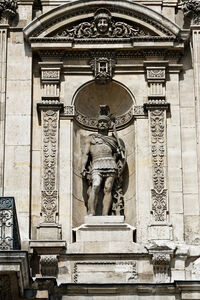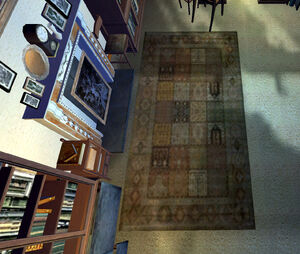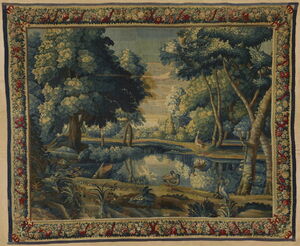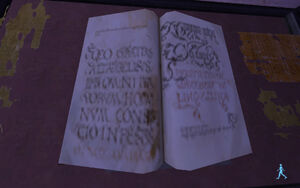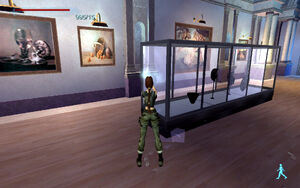This is the third part of Louvre Galleries. The parts of this level consist of: in the open air, Margot Carviers' office and the room with paintings to the archaeological dig.
In the open air, known references[]
10B.01 - Bucranium[]
These motifs comes from antiquity, and it is called a Bucranium. During the renaissance it was used at buildings. Found a bucranium that looks like it, it came from the Ara Pacis building from 13 BC. But I didn’t found it on the exterior in the Louvre.
Fun fact: there is also a bucranium in Tomb Raider 1: The Cistern
10B.02 - Composed relief[]
It is a mashup:
- First one is unclear
- But the central figure is similar to the frontispiece of the Parthenon (the so-called metopes), nowadays at British Museum. The image is mirrored, tho. It might be one of the Centaure fights instead of the Panathenian ride walk.
- And the last figure is the Athenian lady Hegisto, from the funerary stele that has her name. She appears chosing her jewels from a case a female slave brings her.
10B.03 - Mythologic figure[]
It is part of the exterior of the Louvre building. The north facade of the Louvre contains statues in niches. This is one of them.
10B.04 - Mythologic figure[]
I think it is a mashup of several figures.
- The giant head is a reference to the south facade of Grande Galerie.
- The angelic figures came from somewhere else.
In the open air, unknown references[]
10B.05 - relief[]
Unknown maybe the exterior of the Louvre building.
10B.06 - object[]
Some kind of object that requires you to log in. Reused in the Kurtis levels.
Margot Carviers' office, known references[]
Lara got to Margot Carviers' room, her objective. We skip the two rooms, the security room and the xray room.
10B.07 - Love and life[]
- Creator: George Frederic Watts (1817-1904) [1]
- Made in: 1884-1885
- Name: Love and life
- Current location: Tate Britain formally known as Tate Gallery, London, UK.
- Original: https://commons.wikimedia.org/wiki/File:Love_and_Life.jpg
Information from Tate Britain[2]:
Of all the ‘symbolical’ paintings Watts donated to Tate, he said that ‘probably Love and Life best portrays [my] message to the age.’ Love is represented by the woman on the left, and Life by the winged figure. He described the painting as ‘frail and feeble human existence aided to ascend ... by Love with its wide wings of sympathy, charity, tenderness and human affection’. Watts further explained that the two figures are ‘unclothed for they are only symbols’. In 1893, Watts gave versions of the painting to the national collections in France and the United States.
This is a reference to the Nephilim and having relationship with human kind.
10B.08 - Mountains[]
This is an Easter Egg, read more here.
10B.09 - Map[]
A map of Bulgaria, Greece and Turkey. It is a small hint of a location of "Game II". See the easter egg page.
10B.10 - Art Nouveau lamp[]
This art nouveau lamp reminds me of the Tiffany lamp. Check out the other ones:
10B.11 - Castle Kriegler[]
This is an Easter Egg, read more here.
10B.12 - Carpet[]
The designers looked after each detail. On the floor lies a nice Persian carpet. There are a lot of carpets with a block system in the middle.
10B.12 - Painting[]
- Creator: Flanders, Brussels, Atelier de tissage
- Made in: around 1640-1660
- Name: Verdure avec un étang au milieu des arbres
- Current location: Louvre Museum
- Original: https://collections.louvre.fr/en/ark:/53355/cl010101468
This is a tapestry. Also called the Abusson verdure. A vedure is a forest themed tapestry used in 17th century. Some of the vendure came from Flanders, but these one came from Abusson. I try to search it but there are so many images that looks like these.
10B.13 - Cd of Mozart[]
Cd from Mozart (I think).
Margot Carviers' office, unknown references[]
10B.14 - Tiny statue[]
Unknown headless statue.
10B.15 - Stamps[]
Some stamps. Might think these came from Prague, or Turkey or Germany or France. Those who know: let me know.
Room with paintings and staircase to the archaeological dig, known references[]
10B.16 - Painting[]
- Creator: Joseph Wright of Derby (1734-1797) [3]
- Made in: ??
- Name: A cottage on fire at night
- Current location: Unknown
- Original: https://commons.wikimedia.org/wiki/File:A_cottage_on_fire_at_night_.jpg
Don't know if it is a coincidence, but the artist came from from Derby. And Core Design was based in Derby.
10B.17 - The Nicomachean Ethics[]
- Writer: Aristotle (384-322 BC) [4]
- Translated by: Leonardo Aretino Bruni.
- Cover by: Gabriel Altadell [5]
- Title: Nicomachean Ethics [6]
- Made in: 1458-1459
- Came from: https://www.schoyencollection.com/scribes-collection/colophons/aristotle-ethics-ms-111
More information:
The Nicomachean Ethics had an important influence on the European Middle Ages, and was one of the core works of medieval philosophy. As such, it was of great significance in the development of all modern philosophy as well as European law and theology. Aristotle became known as "the Philosopher" (for example, this is how he is referred to in the works of Thomas Aquinas). In the Middle Ages, a synthesis between Aristotelian ethics and Christian theology became widespread, as introduced by Albertus Magnus. The most important version of this synthesis was that of Thomas Aquinas. Other more "Averroist" Aristotelians such as Marsilius of Padua were also influential.
10B.18 - Pancaratnagita[]
Image of an 18th century manuscript of the Bhagavad-gita.
- Writer: Unknown
- Title: Pancaratnagita, the Bhagavadgita with accompanying texts
- Made in: ca. 1800 in Kashmir
- Came from: https://www.schoyencollection.com/23-religions/living-religions/23-16-hinduism/ithasas/pancaratnagita-ms-2099
Information: [7]
The Bhagavadgita or Gita is part of the epic Mahabharata. It forms the chapters 23-40 of book 6 of the Mahabharata called the Bhisma Parva. The work is dated to the second half of the first millennium BCE.
10B.19 - Old Norwegian Girdle Calendar[]
- Writer: unknown
- Title: CALENDAR WITH GOLDEN NUMBERS, FEASTDAYS, OCCUPATIONS OF THE MONTHS AND HOURS OF LIGHT AND DARKNESS, TABLE WITH GOOD AND EVIL DAYS
- Made in: 1636
- Came from: https://www.schoyencollection.com/calendars-almanacs/folding-calendars/norwegian-girdle-calendar-ms-2913
It represent the months January (Ianuari), February (Februari), March (Martius), April (Aprilis), May (Majus) and June (Junius).
10B.20 - Stone with inscriptions[]
- Made in: 721-705 BCE.
- Name: Dénomination : orthostate
- Current location: Louvre Museum
- Original: https://collections.louvre.fr/en/ark:/53355/cl010122698
- Current location: The Louvre Museum
The picture represents Sargon II, ruler of Assyria. It came from the palace at Durr-Sharrukin.
10B.21 - Juvenal Satires and The murder of Brunhila[]
It contains two books.
Book 1:
- Original writer: Decimus Junius Juvenalis [8]
- Title: Satires of Juvenal[9]
- Made in: 1453
- Came from: https://www.schoyencollection.com/literature-collection/classical-roman-literature-collection/juvenal-satires-ms-2047
The author makes constant allusion to history and myth as a source of object lessons or exemplars of particular vices and virtues. Coupled with his dense and elliptical Latin, these tangential references indicate that the intended reader of the Satires was highly educated. The Satires are concerned with perceived threats to the social continuity of the Roman citizens: social-climbing foreigners, unfaithfulness, and other more extreme excesses of their own class. The intended audience of the Satires constituted a subset of the Roman elite, primarily adult males of a more conservative social stance.
Book 2:
- Writer: Maître François
- Title: BOCCACCIO: DES CAS NOBLES HOMMES ET FEMMES
- Made in: 1475
- Came from: https://www.schoyencollection.com/literature-collection/medieval-renaissance-literature-collection/boccaccio-ms-268
10B.22 - Lombardus: the great gloss[]
- Writer: Unknown
- Title: LOMBARDUS: THE GREAT GLOSS
- Made in: 1200, France
- Came from: https://www.schoyencollection.com/bindings-bookboxes/precious-metal-painted/lombardus-great-gloss-ms-258
MS in Latin on vellum, Paris, France, ca. 1200, 204 ff. (complete), 28x20 cm, 2 columns, (19x12 cm), 55 lines in regular early Gothic book script of high grade and very good quality, by at least 3 scribes, marginal glosses within elegant triangular designs in an exquisite Gothic book script, authorities in narrow columns in outer margins in red, 1-line initials in blue or red sometimes with flourishes, 3-line Psalm initials in biblical text in dark blue or red with penwork, 18 4-to 16-line illuminated and 2 historiated initials in very elaborate and delicate designs of intertwined spiral stems with the heads of dragons and lions, lush leaves and clambering animals in colours, tracery and burnished gold, related to the finest MSS of the workshop of Ptolemy's Almagest (B.N. ms. lat. 16200), copied from an exemplar at St. Victor in Paris.
10B.23 - Lucius Annaeus Seneca Epistolae[]
- Writer: Lucius Annaeus Seneca
- Title: LUCIUS ANNAEUS SENECA: EPISTOLAE INCLUDING THE SPURIOUS CORRESPONDENCE WITH ST. PAUL
- Made in: 1440, Italy
- Came from: https://www.schoyencollection.com/literature-collection/classical-roman-literature-collection/seneca-epistolae-ms-2106
10B.24 - Coptic portrait from Egypt[]
Mummy portrait of a woman, Antinopolis. Around 200-249 Roman Empire in Egypt. Now in the Louvre Museum: https://collections.louvre.fr/en/ark:/53355/cl010008804
10B.25 - Mathematical figure[]
- Writer: Unknown.
- Title: QU'RAN (CHINA)
- Made in: Late 16th to early 17th Century
- Came from: https://www.schoyencollection.com/23-religions/living-religions/23-13-islam/quran-koran-collection/china-quran-ms-4475
10B.26 - Cadmus fighting a dragon[]
- Title: Krater
- Made in: 360-350 BCE, ancient Greece
- Came from: https://collections.louvre.fr/en/ark:/53355/cl010274344
- Current location: The Louvre Museum
It is called a Calyx vessel. It depicts Cadmus and his fight with the dragon.
10B.27 - Birdcatcher cup[]
- Title: coupe de l'oiseleur
- Made in: 550 BCE.
- Came from: https://collections.louvre.fr/en/ark:/53355/cl010269930
- Current location: The Louvre Museum
Room with paintings and staircase to the archaeological dig, unknown references[]
10B.28 - Floor mosaic[]
Another mosaic.
Trivia[]
10B.29 - Hidden rooms and guard[]
Some of the rooms in the outside of the Louvre has textures and you can run in these rooms. Some of the rooms have guards in it. I think it was build to make it difficult for the player to progress. The guards would spot Lara and more guards would appear.
10B.30 - Screen[]
One feature - that was scrapped - was that Lara can look on the internet and search more about some topic. But internet in 2000s was another experience than nowdays.
This is the website of Vasiley. Notice the Lux Veritatis logo in the "V". I don't know about the three pictures on the background, it could be antique. Because Matthias Vasiley was an art dealer (I think). The note with the password (who does that anyway) looks like it was written by a pirate GRG RGR RGHRH HRRHERRH etc.
10B.31 - Shooting the cabinets[]
Lara can shoot at the glasses with shows us antiquity’s. That effect is a function which is inside the GMX files called FERGYSMASHGLASS_SMASH. This is a reference to Fergus Duggan a developer. You can view it yourself with a tool called unGMX v.1.0 by Nakamichi680. Screenshots of the .chr and .cal files and some gibberish of the FERGYSMASHCLASS.CHR file. I cannot explain it, it is just there and someday we can build our own levels.
Notes and references[]
- ↑ https://en.wikipedia.org/wiki/George_Frederic_Watts
- ↑ https://www.tate.org.uk/art/artworks/watts-love-and-life-n01641
- ↑ https://en.wikipedia.org/wiki/Joseph_Wright_of_Derby
- ↑ https://en.wikipedia.org/wiki/Aristotle
- ↑ https://research.frick.org/spanish/detail/1681
- ↑ https://en.wikipedia.org/wiki/Nicomachean_Ethics
- ↑ https://en.wikipedia.org/wiki/Bhagavad_Gita
- ↑ https://en.wikipedia.org/wiki/Juvenal
- ↑ https://en.wikipedia.org/wiki/Satires_(Juvenal)






